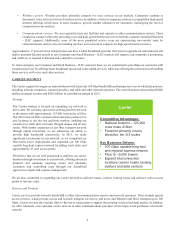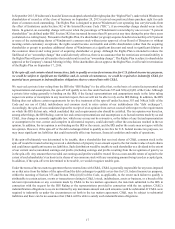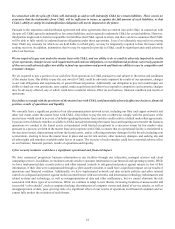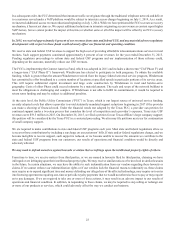Windstream 2015 Annual Report Download - page 98
Download and view the complete annual report
Please find page 98 of the 2015 Windstream annual report below. You can navigate through the pages in the report by either clicking on the pages listed below, or by using the keyword search tool below to find specific information within the annual report.16
Increases in broadband usage may cause network capacity limitations, resulting in service disruptions or reduced capacity for
customers.
Video streaming services and peer-to-peer file sharing applications use significantly more bandwidth than traditional Internet
activity such as web browsing and email. As utilization rates and availability of these services continue to grow, our high-speed
Internet customers may use much more bandwidth than in the past. If this occurs, we could be required to make significant capital
expenditures to increase network capacity to avoid service disruptions or reduced capacity for customers.
Alternatively, we may choose to implement reasonable network management practices to reduce the network capacity available
to bandwidth-intensive activities during certain times in market areas experiencing congestion, and these actions could negatively
affect customer experience and increase customer churn.
While we believe demand for these services may drive high-speed Internet customers to pay for faster broadband speeds, we may
not be able to recover the costs of the necessary network investments. This could result in an adverse impact to our results of
operations and financial condition.
Disruptions and congestion in our networks and infrastructure may cause us to lose customers and incur additional expenses.
Our customers depend on reliable service over our network. Some of the risks to our network infrastructure include physical
damage to lines, security breaches, capacity limitations, power surges or outages, software defects and disruptions beyond our
control, such as natural disasters and acts of terrorism. From time to time in the ordinary course of business, we will experience
disruptions in our service due to factors such as cable damage, inclement weather and service failures of our third party service
providers. Additionally, we could face disruptions due to capacity limitations as a result of changes in our customers’ high-speed
Internet usage patterns. These patterns have changed in recent years, for example through the increased usage of video, resulting
in a significant increase in the utilization of our network.
We could experience more significant disruptions in the future. Disruptions may cause interruptions in service or reduced capacity
for customers, either of which could cause us to lose customers or incur additional expenses or capital expenditures. Such results
could adversely affect our results of operations and financial condition.
The value of our retained interest in CS&L could be impacted by future sales or distributions of shares of CS&L common
stock, which could make it difficult to liquidate some or all of our retained interest at favorable market prices.
In the spin-off, we retained a passive ownership interest in approximately 19.6 percent of CS&L common stock. We intend to use
all of our shares of CS&L to retire additional Windstream Services debt within 18 to 24 months from the date of the spin-off,
subject to market conditions. In addition, some of the holders of shares of CS&L common stock are index funds tied to stock or
investment indices or are institutional investors bound by various investment guidelines. Companies are generally selected for
investment indices, and in some cases selected by institutional investors, based on factors such as market capitalization, industry,
trading liquidity and financial condition. CS&L common stock may not qualify for those investment indices and may not meet
the investment guidelines of some institutional investors. Consequently, these index funds and institutional investors may have to
sell some or all of our common stock they receive in the spin-off.
Any disposition by us or any other significant shareholder of CS&L of shares of CS&L common stock, or the perception in the
market that such dispositions could occur, may cause the share price of CS&L common stock to fall. Any such decline could impair
our ability to sell our shares of CS&L common stock in the future at favorable market prices, reduce the value of our retained
interest in CS&L, and impact our plans to retire debt as planned in a debt for equity exchange.
A change in ownership may limit our ability to utilize our net operating loss carryforwards.
If Windstream experiences a 50% or greater change in ownership involving shareholders owning 5% or more of its stock, it could
adversely impact Windstream’s ability to utilize its existing net operating loss carryforwards. The inability to utilize existing net
operating loss carryforwards would significantly increase the amount of Windstream's annual cash taxes reducing the overall
amount of cash available to be used in other areas of the business.
























